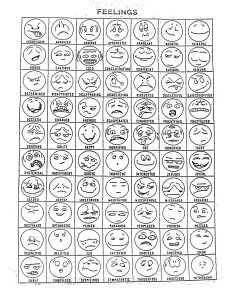
The class started with asking the children what they understood of each expression. All conversations with them were in Hindi. But the printout wasn’t clear enough, so I had to write most of the words on the board and explain the meaning of each in Hindi. I realized later that I was over-expecting the children to know what words like ‘hysterical’ and ‘eavesdropping’ meant. Of course. Some children asked me to use the word in a sentence, leading to this silence from my side with my head spinning for a while on Saturday morning on how to break this down in an interesting way for a 12-year-old. It better be interesting; in case I used too ‘grown-up’ examples, it could lead to disconnect with them. This led me to acting out some of the words. This is where the fun started. I got giggles with explaining ‘love struck’ with participation from the backbenchers, some blanked out looks with ‘hung-over’. Most words were not easy to explain to my satisfaction, like the difference between ‘arrogant’ and ‘obstinate’. Asking them what Bollywood actor they thought were arrogant and obstinate got us some interesting common answers! Cricket and Bollywood- two great aids in teaching, I tell you; always works with children to get them interested.
Children understood the more ‘physical’ meanings of words like ‘pained’ and ‘hurt’ than the emotional meanings, which gave me this ‘it-will-take-them-a-while-to-figure-that-one’ sense. ‘Horrified’ meant more than just what you felt in a horror film, like a mother’s reaction to what children could do to their rooms. ‘Optimistic’ was not the same as ‘Happy’ and ‘Blissful’ and had to be explained in contrast to ‘Pessimistic’. A lot of the examples were examination related because at this age, I figured exams brought in some amount of reactions and emotions- no thanks to my formative years of high stress on academics. These were- I was ‘relieved’ when the exams were over’; the parents were ‘shocked’ at the child’s results; I was ‘ecstatic’ when I was declared first in class. Some words that I still have to act out convincingly are ‘smug’ and ‘sheepish’! In case you find this funny, try doing this in front of 24 odd children. It takes an experienced stage artist to hold, engage and convey effectively! Words like aggressive, disapproving, grieving, frustrated and exasperated took a while to communicate. They were also writing down the hindi meanings of each word in their sketch books, which made me realize how important this class was for them.
It felt like a good day with one substantial hour spent here, with some amount of self-introspection, questioning my ability to communicate to an audience with simple words.

Hey Arjun, need to know more about Saksham, you got contacts/addresses? Saon
ReplyDeleteHey.. Will mail you the address. You can meet them and you can contribute in any way you like. Cheers!
ReplyDelete